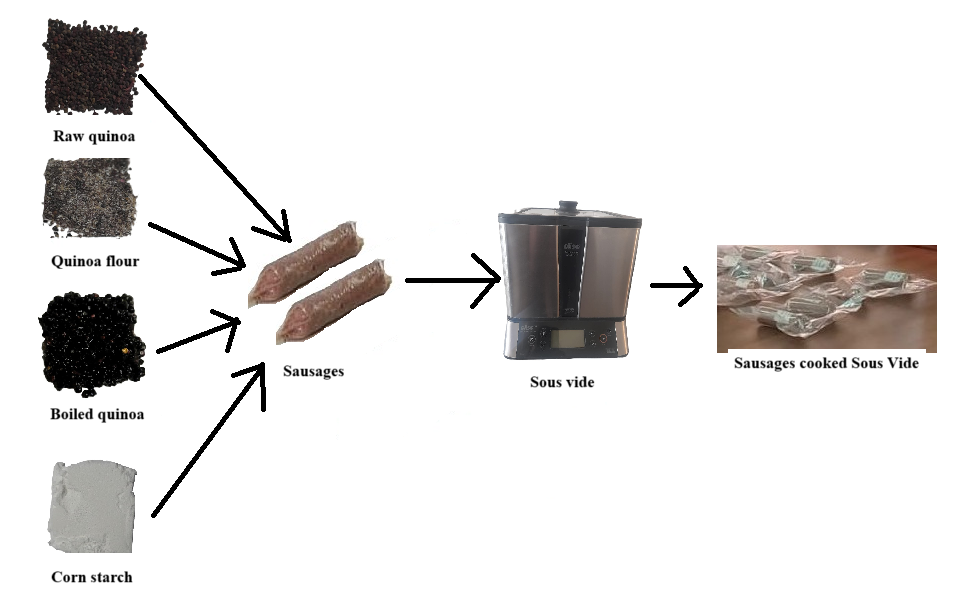Capacidade antioxidante e oxidação lipídica de salsichas de alpaca com quinoa vermelha cozida Sous Vide
Resumo
Atualmente, o consumo de salsichas tem sido associado a problemas de saúde devido ao seu alto teor de ácidos graxos e colesterol, necessitando do uso de carnes com baixo teor de gordura, antioxidantes naturais, extensores e novas tecnologias de processamento para manter suas propriedades nutricionais e reduzir a oxidação. O objetivo deste estudo foi avaliar o efeito da quinoa vermelha como extensor na capacidade antioxidante e oxidação lipídica em salsichas de alpaca cozidas em diferentes temperaturas usando sous vide. Para o estudo, salsichas de alpaca foram feitas misturando carne de alpaca moída, sal, gordura animal e extensores (quinoa crua, farinha de quinoa, quinoa cozida e amido de milho). As misturas foram cozidas em sous vide a 60 e 80 °C e armazenadas a 50 °C por 12 dias, coletando amostras nos dias 1, 7 e 12, para determinar a capacidade antioxidante (método ABTS), oxidação lipídica (método TBARS), pH, cor e textura. Os resultados indicaram que os maiores valores de capacidade antioxidante foram obtidos em linguiças de alpaca com farinha de quinoa, causando menor grau de oxidação lipídica, indicado pelo baixo valor de TBARS, além de maior estabilidade nos valores de pH, luminosidade (L*), vermelhidão (a*) e menor descoloração (b*), o que pode ser atribuído aos antioxidantes fenólicos da quinoa vermelha. Em conclusão, o uso da quinoa vermelha é uma alternativa, pois, não só pode ser um extensor na produção de linguiças, mas também porque inibe a oxidação lipídica e melhora a atividade antioxidante do produto.
Downloads
Referências
Çelebi, U., & Erge, A. (2024). An approach to produce healthier meat products: Effect of k-carrageenan and inulin on quality characteristics of bologna-type chicken sausages. International Journal of Gastronomy and Food Science, 36, 100907. https://doi.org/10.1016/j.ijgfs.2024.100907
Choe, J.-H., Kim, H.-Y., Lee, J.-M., Kim, Y.-J., & Kim, C.-J. (2013). Quality of frankfurter-type sausages with added pig skin and wheat fiber mixture as fat replacers. Meat Science, 93(4), 849-854. https://doi.org/10.1016/j.meatsci.2012.11.054
Cruz-Tirado, J. P., Vieira, M. S. dos S., Correa, O. O. V., Delgado, D. R., Angulo-Tisoc, J. M., Barbin, D. F., & Siche, R. (2024). Detection of adulteration of Alpaca (Vicugna pacos) meat using a portable NIR spectrometer and NIR-hyperspectral imaging. Journal of Food Composition and Analysis, 126, 105901. https://doi.org/10.1016/j.jfca.2023.105901
Deepitha, R. P., Xavier, K. A. M., Layana, P., Nayak, B. B., & Balange, A. K. (2021). Quality improvement of pangasius fillets using aqueous seaweed (Padina tetrastromatica) extract. LWT, 137, 110418. https://doi.org/10.1016/j.lwt.2020.110418
Deng, N., Liu, Y., Cai, Y., Li, H., Li, C., Xiao, Z., Zhang, B., Liu, M., Fang, F., & Wang, J. (2024). Characterization, antioxidant, and sausage preservation effects of ethanol extract from lotus seed peel powder. Food Control, 158, 110202. https://doi.org/10.1016/j.foodcont.2023.110202
Fernández-López, J., Lucas-González, R., Viuda-Martos, M., Sayas-Barberá, E., Ballester-Sánchez, J., Haros, C. M., Martínez-Mayoral, A., & Pérez-Álvarez, J. A. (2020). Chemical and technological properties of bologna-type sausages with added black quinoa wet-milling coproducts as binder replacer. Food Chemistry, 310, 125936. https://doi.org/10.1016/j.foodchem.2019.125936
Huang, Q., Xiong, K., Wang, Y., Xiong, Z., Lu, H., Peng, L., Jin, W., Wang, W., Ni, L., & Wang, H. (2025). Physical and flavor characteristics of reduced sodium sausages containing plant proteins and blends of chloride salts. LWT, 215, 117268. https://doi.org/10.1016/j.lwt.2024.117268
Kasaiyan, S. A., Caro, I., Ramos, D. D., Salvá, B. K., Carhuallanqui, A., Dehnavi, M., & Mateo, J. (2023). Effects of the use of raw or cooked chickpeas and the sausage cooking time on the quality of a lamb-meat, olive-oil emulsion-type sausage. Meat Science, 202, 109217. https://doi.org/10.1016/j.meatsci.2023.109217
Lang, M. (2020). Consumer acceptance of blending plant-based ingredients into traditional meat-based foods: Evidence from the meat-mushroom blend. Food Quality and Preference, 79, 103758. https://doi.org/10.1016/j.foodqual.2019.103758
Li, C., Xie, W., Zhang, X., Liu, J., Zhang, M., & Shao, J. (2023). Pickering emulsion stabilized by modified pea protein-chitosan composite particles as a new fat substitute improves the quality of pork sausages. Meat Science, 197, 109086. https://doi.org/10.1016/j.meatsci.2022.109086
Luan, X., Feng, M., & Sun, J. (2021). Efecto de Lactobacillus plantarum sobre la actividad antioxidante en embutidos fermentados. Food Research International, 144, 110351. https://doi.org/10.1016/j.foodres.2021.110351
Ma, Q., Li, Z., Kumrungsee, T., Huang, W., & Cao, R. (2023). Effect of pressure cooking on phenolic compounds of quinoa. Grain & Oil Science and Technology, 6(3), 127-134. https://doi.org/10.1016/j.gaost.2023.03.001
Manzoor, A., Ahmad, S., & Yousuf, B. (2022). Effect of bioactive-rich mango peel extract on physicochemical, antioxidant and functional characteristics of chicken sausage. Applied Food Research, 2(2), 100183. https://doi.org/10.1016/j.afres.2022.100183
Monteiro, G. M., Souza, X. R., Costa, D. P. B., Faria, P. B., & Vicente, J. (2017). Partial substitution of pork fat with canola oil in Toscana sausage. Innovative Food Science & Emerging Technologies, 44, 2-8. https://doi.org/10.1016/j.ifset.2017.07.013
Muchekeza, J. T., Jombo, T. Z., Magogo, C., Mugari, A., Manjeru, P., & Manhokwe, S. (2021). Proximate, physico-chemical, functional and sensory properties OF quinoa and amaranth flour AS potential binders in beef sausages. Food Chemistry, 365, 130619. https://doi.org/10.1016/j.foodchem.2021.130619
Naqvi, Z. B., Campbell, M. A., Latif, S., Thomson, P. C., Astruc, T., Friend, M. A., Vaskoska, R., & Warner, R. D. (2022). The effect of extended refrigerated storage on the physicochemical, structural, and microbial quality of sous vide cooked biceps femoris treated with ginger powder (zingibain). Meat Science, 186, 108729. https://doi.org/10.1016/j.meatsci.2021.108729
Nyaguthii, K. C., Omwamba, M., & Nduko, J. M. (2023). Gum arabic and soy protein concentrate as binding agents on quality and nutritional properties of mushroom-based sausage analogues. Food and Humanity, 1, 1627-1636. https://doi.org/10.1016/j.foohum.2023.11.010
Owusu-Ansah, P., Besiwah, E. K., Bonah, E., & Amagloh, F. K. (2022). Non-meat ingredients in meat products: A scoping review. Applied Food Research, 2(1), 100044. https://doi.org/10.1016/j.afres.2022.100044
Pintado, T., & Delgado-Pando, G. (2020). Towards More Sustainable Meat Products: Extenders as a Way of Reducing Meat Content. Foods, 9(8), Article 8. https://doi.org/10.3390/foods9081044
Re, R., Pellegrini, N., Proteggente, A., Pannala, A., Yang, M., & Rice-Evans, C. (1999). Antioxidant activity applying an improved ABTS radical cation decolorization assay. Free Radical Biology and Medicine, 26(9), 1231-1237. https://doi.org/10.1016/S0891-5849(98)00315-3
Rocchetti, G., Ferronato, G., Sarv, V., Kerner, K., Venskutonis, P. R., & Lucini, L. (2023). Meat extenders from different sources as protein-rich alternatives to improve the technological properties and functional quality of meat products. Current Opinion in Food Science, 49, 100967. https://doi.org/10.1016/j.cofs.2022.100967
Rosmini, M. R., Perlo, F., Pérez-Alvarez, J. A., Pagán-Moreno, M. J., Gago-Gago, A., López-Santoveña, F., & Aranda-Catalá, V. (1996). TBA test by an extractive method applied to ‘paté’. Meat Science, 42(1), 103-110. https://doi.org/10.1016/0309-1740(95)00010-0
Sharma, S., Kataria, A., & Singh, B. (2022). Effect of thermal processing on the bioactive compounds, antioxidative, antinutritional and functional characteristics of quinoa (Chenopodium quinoa). LWT, 160, 113256. https://doi.org/10.1016/j.lwt.2022.113256
Smith, M. A., Nelson, C. L., Biffin, T. E., Bush, R. D., Hall, E. J. S., & Hopkins, D. L. (2019). Vitamin E concentration in alpaca meat and its impact on oxidative traits during retail display. Meat Science, 151, 18-23. https://doi.org/10.1016/j.meatsci.2019.01.004
Wang, Y., Wang, W., Jia, H., Gao, G., Wang, X., Zhang, X., & Wang, Y. (2018). Using Cellulose Nanofibers and Its Palm Oil Pickering Emulsion as Fat Substitutes in Emulsified Sausage. Journal of Food Science, 83(6), 1740-1747. https://doi.org/10.1111/1750-3841.14164
Zeraat Pisheh, F., Pirnia, M., Falah, F., Tabatabaei-Yazdi, F., Mortazavi, S. A., & Vasiee, A. (2025). Innovative edible coatings: Lactiplantibacillus plantarum postbiotics and chitosan as a clean-label strategy for sausage preservation. Applied Food Research, 5(1), 100958. https://doi.org/10.1016/j.afres.2025.100958
Zhang, M., Chen, M., Fang, F., Fu, C., Xing, S., Qian, C., Liu, J., Kan, J., & Jin, C. (2022). Effect of sous vide cooking treatment on the quality, structural properties and flavor profile of duck meat. International Journal of Gastronomy and Food Science, 29, 100565. https://doi.org/10.1016/j.ijgfs.2022.100565

Direitos de Autor (c) 2025 Marienela Calsin-Cutimbo, Juan Aro-Aro, Nury Mayta-Barrios

This work is licensed under a Creative Commons Attribution-NonCommercial-ShareAlike 4.0 International License.

















